Business Economics Assignment: Application of Economic Theories
VerifiedAdded on 2023/04/22
|24
|2848
|425
Homework Assignment
AI Summary
This business economics assignment explores various economic concepts and principles. Part A delves into microeconomic topics, examining the impact of oil prices on demand, externalities, and public goods. It analyzes scarcity, opportunity cost, and production possibility frontiers. The assignment also addresses elasticity, including income and cross-price elasticity, and explores different market structures, specifically perfect competition, covering short-run and long-run equilibrium for firms. Part B shifts to macroeconomic principles, calculating GDP, GNP, and related economic indicators. It analyzes the effects of fiscal policy, including tax changes and government spending, on aggregate demand and supply. The assignment also covers unemployment types, including frictional and structural unemployment, and examines inflation, differentiating between demand-pull and cost-push inflation. Overall, the assignment provides a comprehensive analysis of both microeconomic and macroeconomic concepts, offering detailed explanations and graphical representations to illustrate key economic principles.
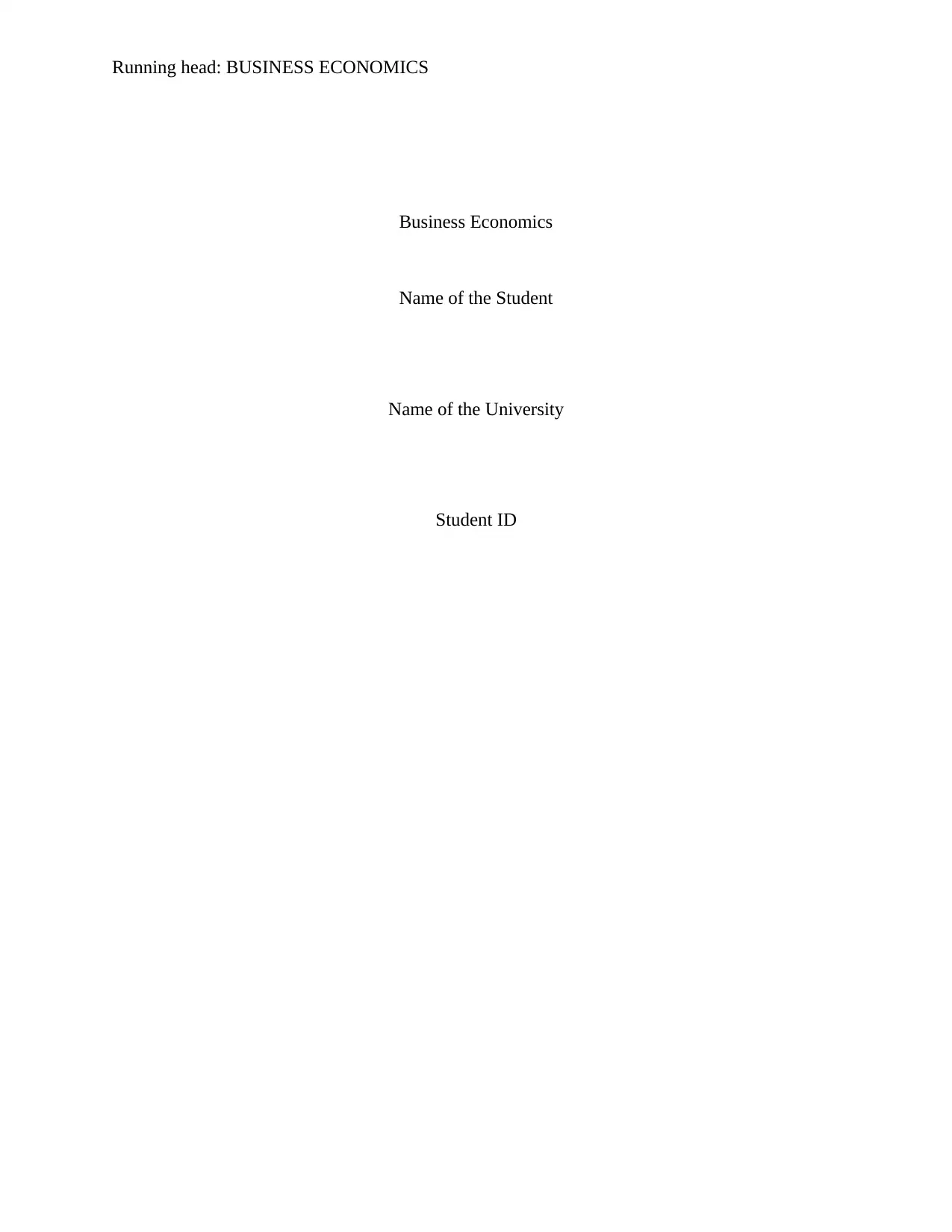
Running head: BUSINESS ECONOMICS
Business Economics
Name of the Student
Name of the University
Student ID
Business Economics
Name of the Student
Name of the University
Student ID
Paraphrase This Document
Need a fresh take? Get an instant paraphrase of this document with our AI Paraphraser
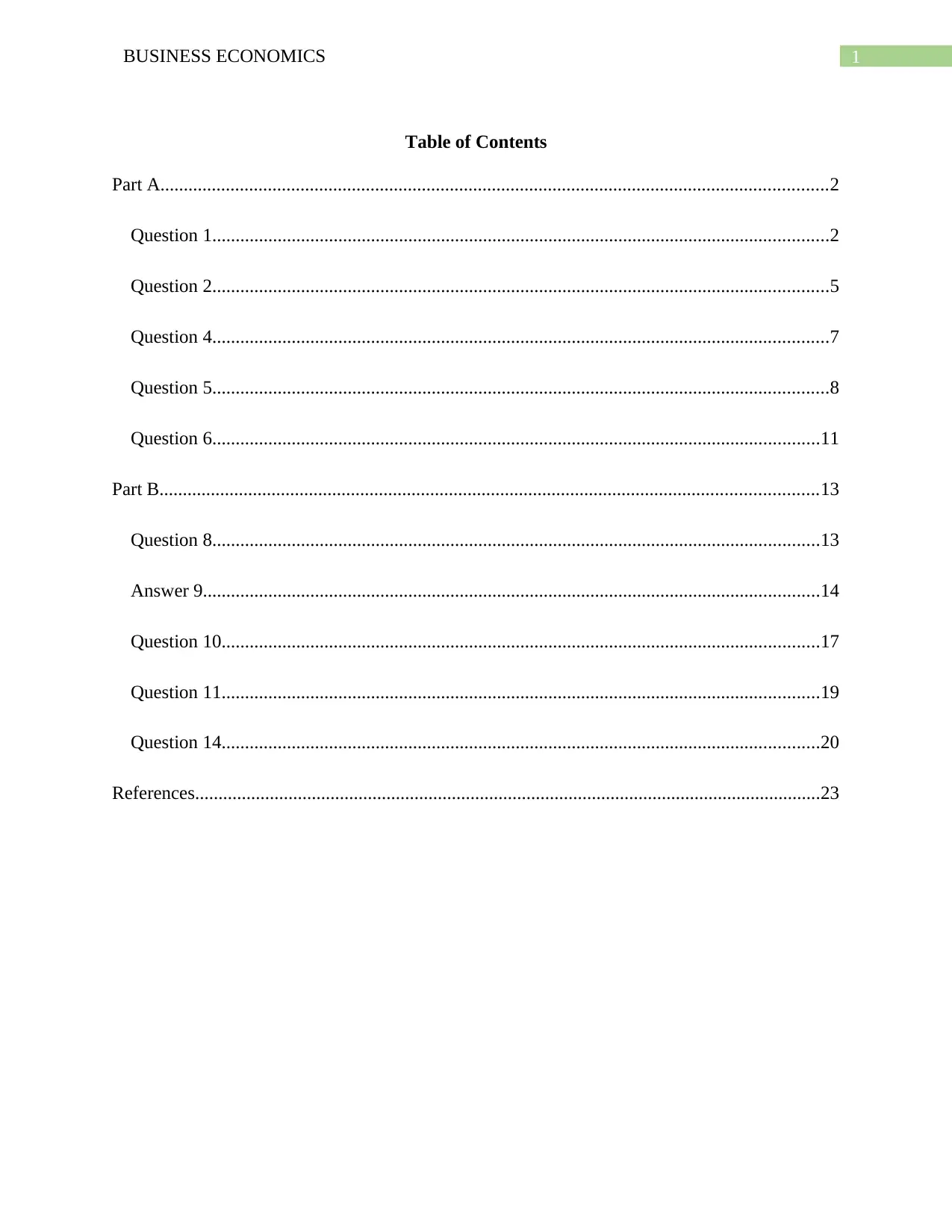
1BUSINESS ECONOMICS
Table of Contents
Part A...............................................................................................................................................2
Question 1....................................................................................................................................2
Question 2....................................................................................................................................5
Question 4....................................................................................................................................7
Question 5....................................................................................................................................8
Question 6..................................................................................................................................11
Part B.............................................................................................................................................13
Question 8..................................................................................................................................13
Answer 9....................................................................................................................................14
Question 10................................................................................................................................17
Question 11................................................................................................................................19
Question 14................................................................................................................................20
References......................................................................................................................................23
Table of Contents
Part A...............................................................................................................................................2
Question 1....................................................................................................................................2
Question 2....................................................................................................................................5
Question 4....................................................................................................................................7
Question 5....................................................................................................................................8
Question 6..................................................................................................................................11
Part B.............................................................................................................................................13
Question 8..................................................................................................................................13
Answer 9....................................................................................................................................14
Question 10................................................................................................................................17
Question 11................................................................................................................................19
Question 14................................................................................................................................20
References......................................................................................................................................23
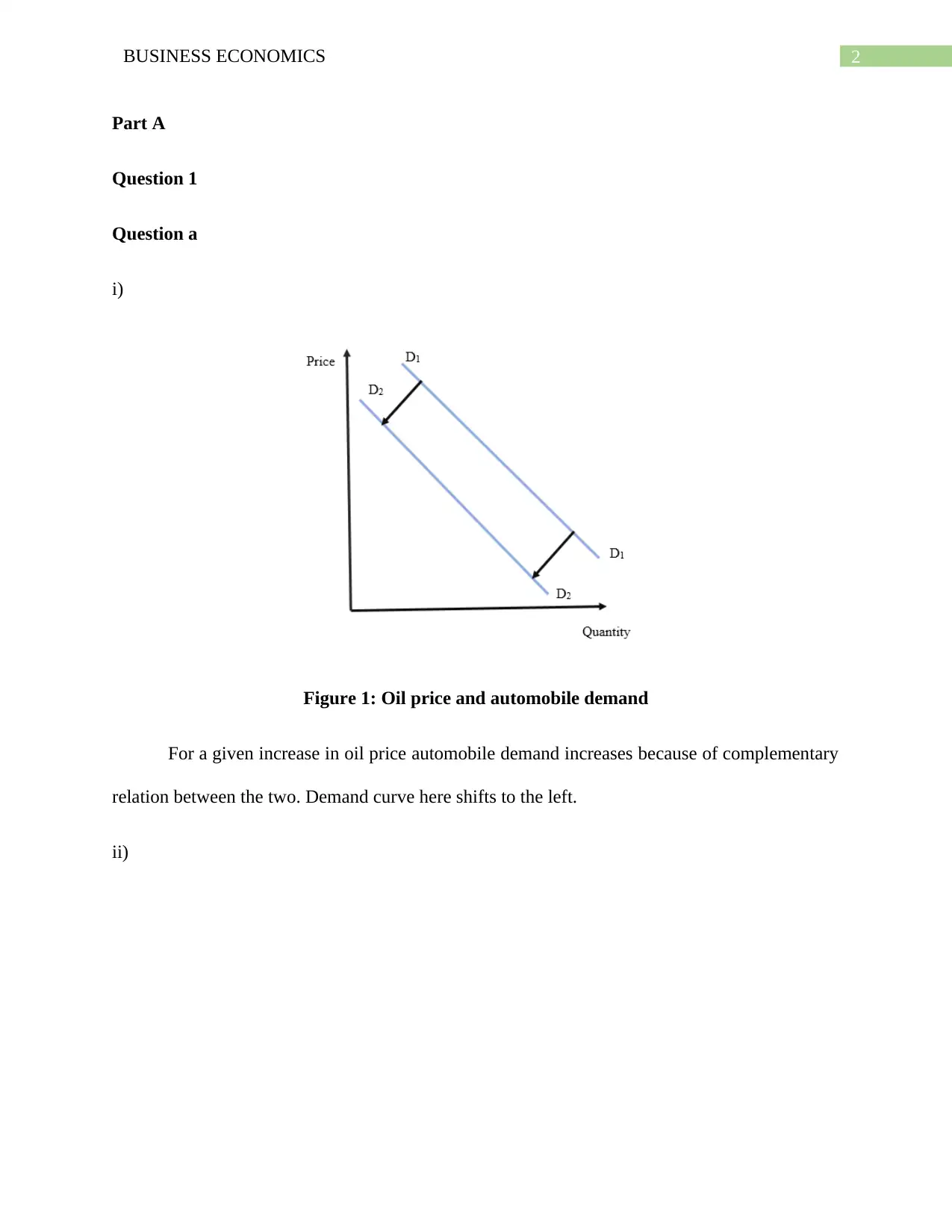
2BUSINESS ECONOMICS
Part A
Question 1
Question a
i)
Figure 1: Oil price and automobile demand
For a given increase in oil price automobile demand increases because of complementary
relation between the two. Demand curve here shifts to the left.
ii)
Part A
Question 1
Question a
i)
Figure 1: Oil price and automobile demand
For a given increase in oil price automobile demand increases because of complementary
relation between the two. Demand curve here shifts to the left.
ii)
⊘ This is a preview!⊘
Do you want full access?
Subscribe today to unlock all pages.

Trusted by 1+ million students worldwide
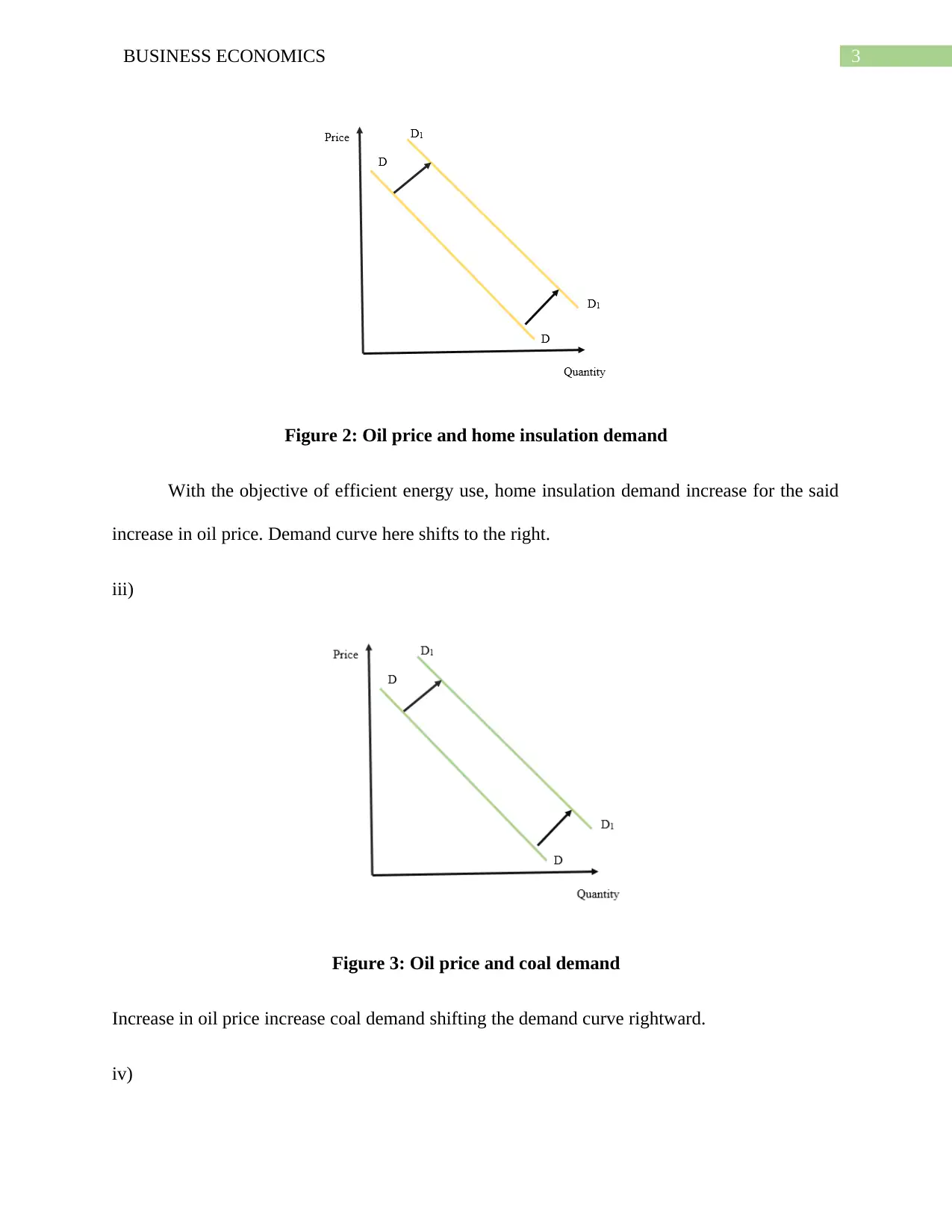
3BUSINESS ECONOMICS
Figure 2: Oil price and home insulation demand
With the objective of efficient energy use, home insulation demand increase for the said
increase in oil price. Demand curve here shifts to the right.
iii)
Figure 3: Oil price and coal demand
Increase in oil price increase coal demand shifting the demand curve rightward.
iv)
Figure 2: Oil price and home insulation demand
With the objective of efficient energy use, home insulation demand increase for the said
increase in oil price. Demand curve here shifts to the right.
iii)
Figure 3: Oil price and coal demand
Increase in oil price increase coal demand shifting the demand curve rightward.
iv)
Paraphrase This Document
Need a fresh take? Get an instant paraphrase of this document with our AI Paraphraser
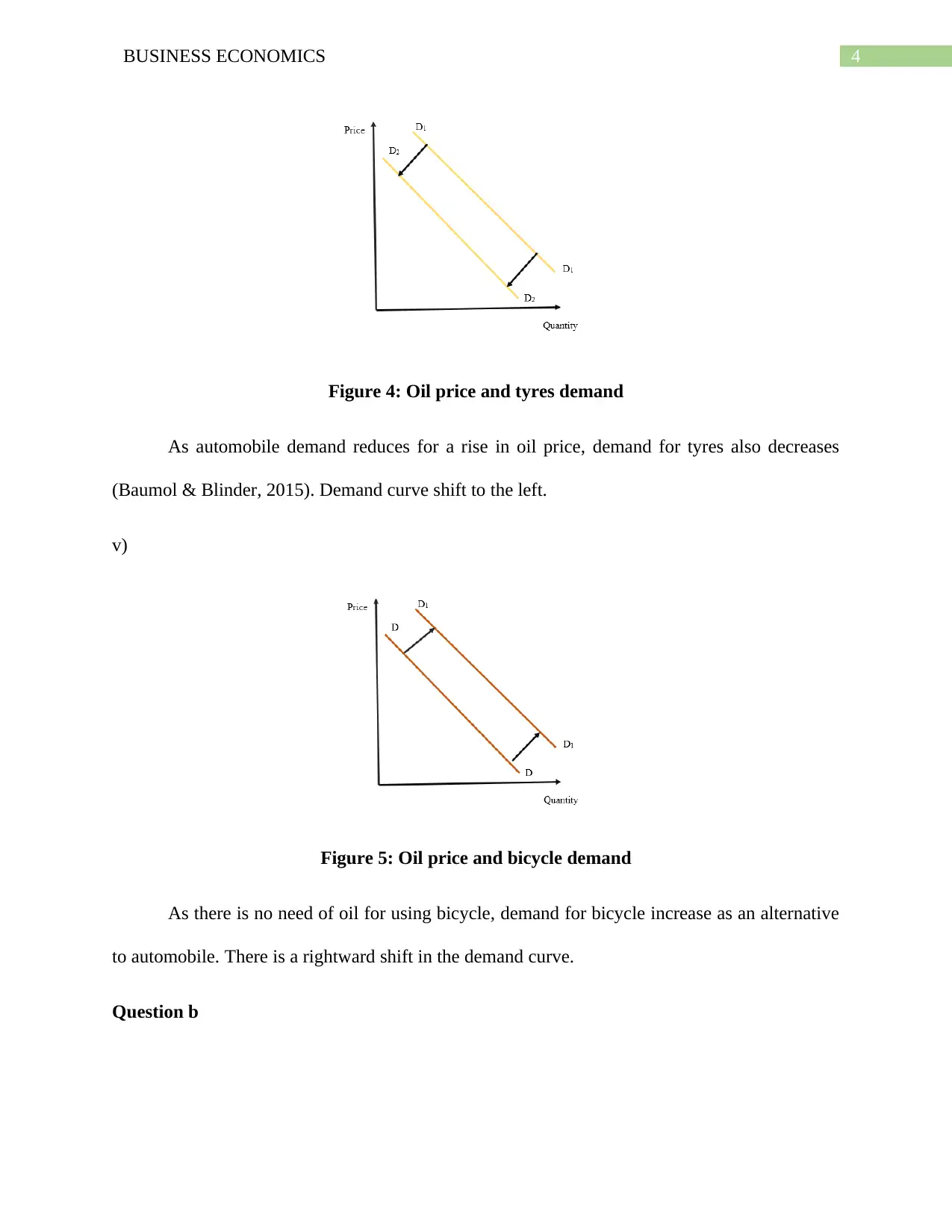
4BUSINESS ECONOMICS
Figure 4: Oil price and tyres demand
As automobile demand reduces for a rise in oil price, demand for tyres also decreases
(Baumol & Blinder, 2015). Demand curve shift to the left.
v)
Figure 5: Oil price and bicycle demand
As there is no need of oil for using bicycle, demand for bicycle increase as an alternative
to automobile. There is a rightward shift in the demand curve.
Question b
Figure 4: Oil price and tyres demand
As automobile demand reduces for a rise in oil price, demand for tyres also decreases
(Baumol & Blinder, 2015). Demand curve shift to the left.
v)
Figure 5: Oil price and bicycle demand
As there is no need of oil for using bicycle, demand for bicycle increase as an alternative
to automobile. There is a rightward shift in the demand curve.
Question b
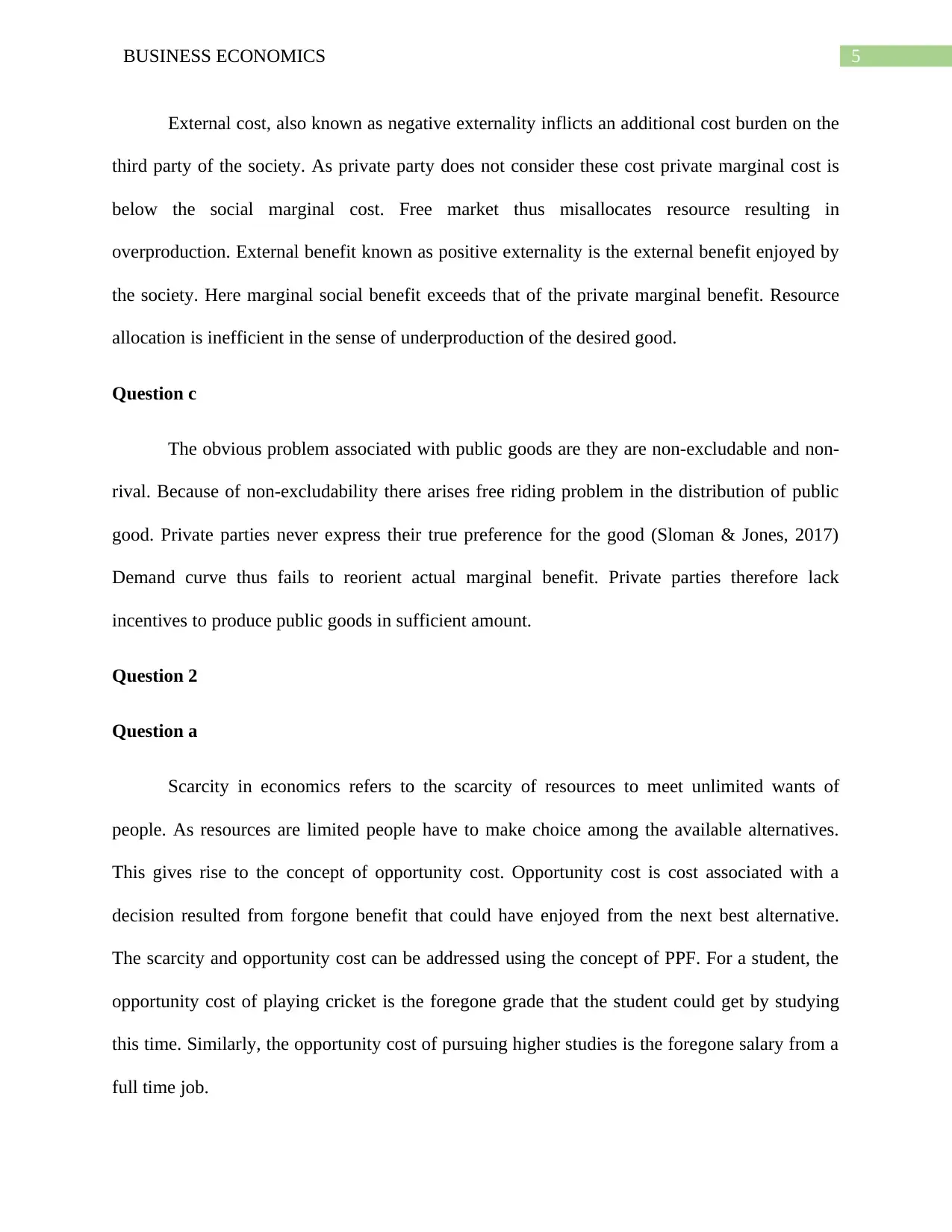
5BUSINESS ECONOMICS
External cost, also known as negative externality inflicts an additional cost burden on the
third party of the society. As private party does not consider these cost private marginal cost is
below the social marginal cost. Free market thus misallocates resource resulting in
overproduction. External benefit known as positive externality is the external benefit enjoyed by
the society. Here marginal social benefit exceeds that of the private marginal benefit. Resource
allocation is inefficient in the sense of underproduction of the desired good.
Question c
The obvious problem associated with public goods are they are non-excludable and non-
rival. Because of non-excludability there arises free riding problem in the distribution of public
good. Private parties never express their true preference for the good (Sloman & Jones, 2017)
Demand curve thus fails to reorient actual marginal benefit. Private parties therefore lack
incentives to produce public goods in sufficient amount.
Question 2
Question a
Scarcity in economics refers to the scarcity of resources to meet unlimited wants of
people. As resources are limited people have to make choice among the available alternatives.
This gives rise to the concept of opportunity cost. Opportunity cost is cost associated with a
decision resulted from forgone benefit that could have enjoyed from the next best alternative.
The scarcity and opportunity cost can be addressed using the concept of PPF. For a student, the
opportunity cost of playing cricket is the foregone grade that the student could get by studying
this time. Similarly, the opportunity cost of pursuing higher studies is the foregone salary from a
full time job.
External cost, also known as negative externality inflicts an additional cost burden on the
third party of the society. As private party does not consider these cost private marginal cost is
below the social marginal cost. Free market thus misallocates resource resulting in
overproduction. External benefit known as positive externality is the external benefit enjoyed by
the society. Here marginal social benefit exceeds that of the private marginal benefit. Resource
allocation is inefficient in the sense of underproduction of the desired good.
Question c
The obvious problem associated with public goods are they are non-excludable and non-
rival. Because of non-excludability there arises free riding problem in the distribution of public
good. Private parties never express their true preference for the good (Sloman & Jones, 2017)
Demand curve thus fails to reorient actual marginal benefit. Private parties therefore lack
incentives to produce public goods in sufficient amount.
Question 2
Question a
Scarcity in economics refers to the scarcity of resources to meet unlimited wants of
people. As resources are limited people have to make choice among the available alternatives.
This gives rise to the concept of opportunity cost. Opportunity cost is cost associated with a
decision resulted from forgone benefit that could have enjoyed from the next best alternative.
The scarcity and opportunity cost can be addressed using the concept of PPF. For a student, the
opportunity cost of playing cricket is the foregone grade that the student could get by studying
this time. Similarly, the opportunity cost of pursuing higher studies is the foregone salary from a
full time job.
⊘ This is a preview!⊘
Do you want full access?
Subscribe today to unlock all pages.

Trusted by 1+ million students worldwide
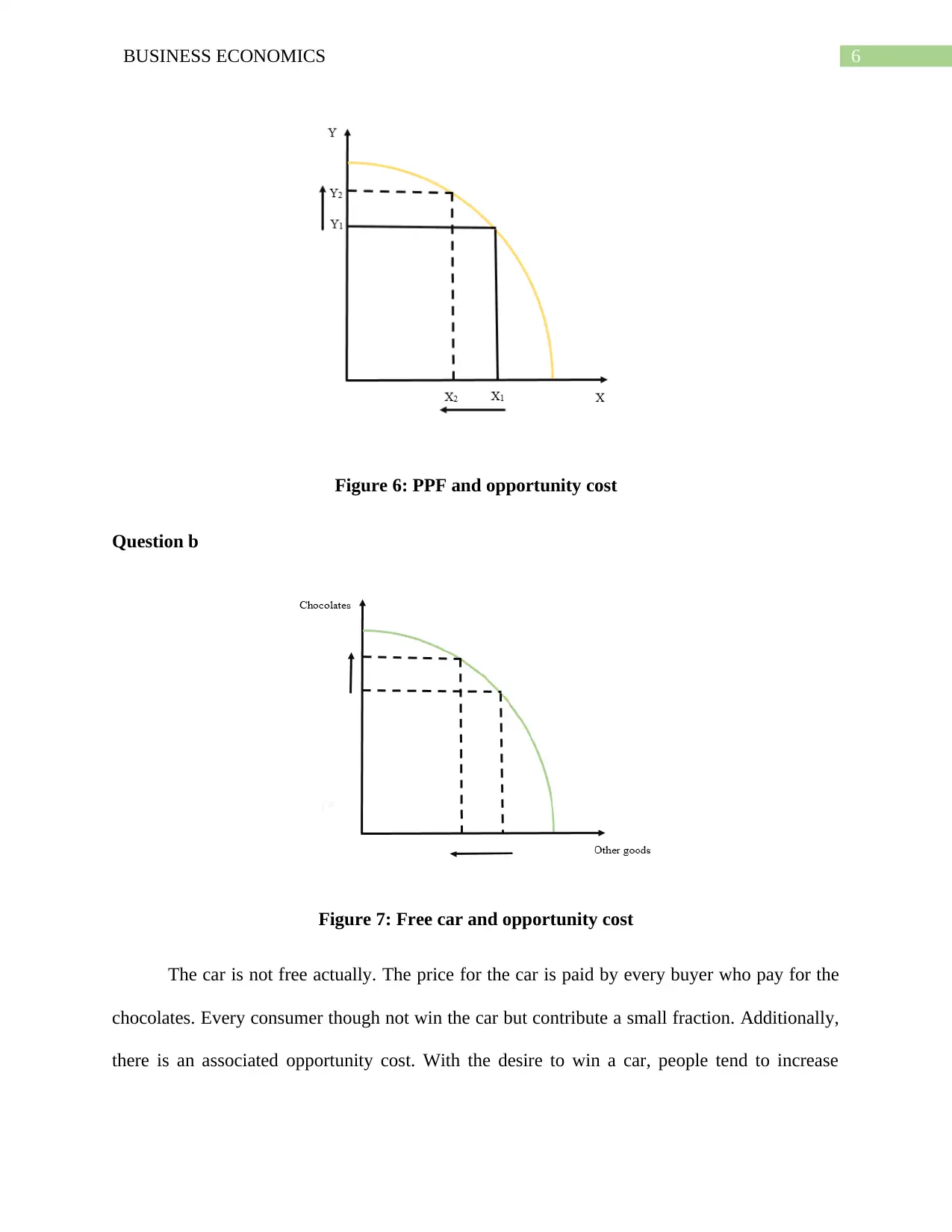
6BUSINESS ECONOMICS
Figure 6: PPF and opportunity cost
Question b
Figure 7: Free car and opportunity cost
The car is not free actually. The price for the car is paid by every buyer who pay for the
chocolates. Every consumer though not win the car but contribute a small fraction. Additionally,
there is an associated opportunity cost. With the desire to win a car, people tend to increase
Figure 6: PPF and opportunity cost
Question b
Figure 7: Free car and opportunity cost
The car is not free actually. The price for the car is paid by every buyer who pay for the
chocolates. Every consumer though not win the car but contribute a small fraction. Additionally,
there is an associated opportunity cost. With the desire to win a car, people tend to increase
Paraphrase This Document
Need a fresh take? Get an instant paraphrase of this document with our AI Paraphraser
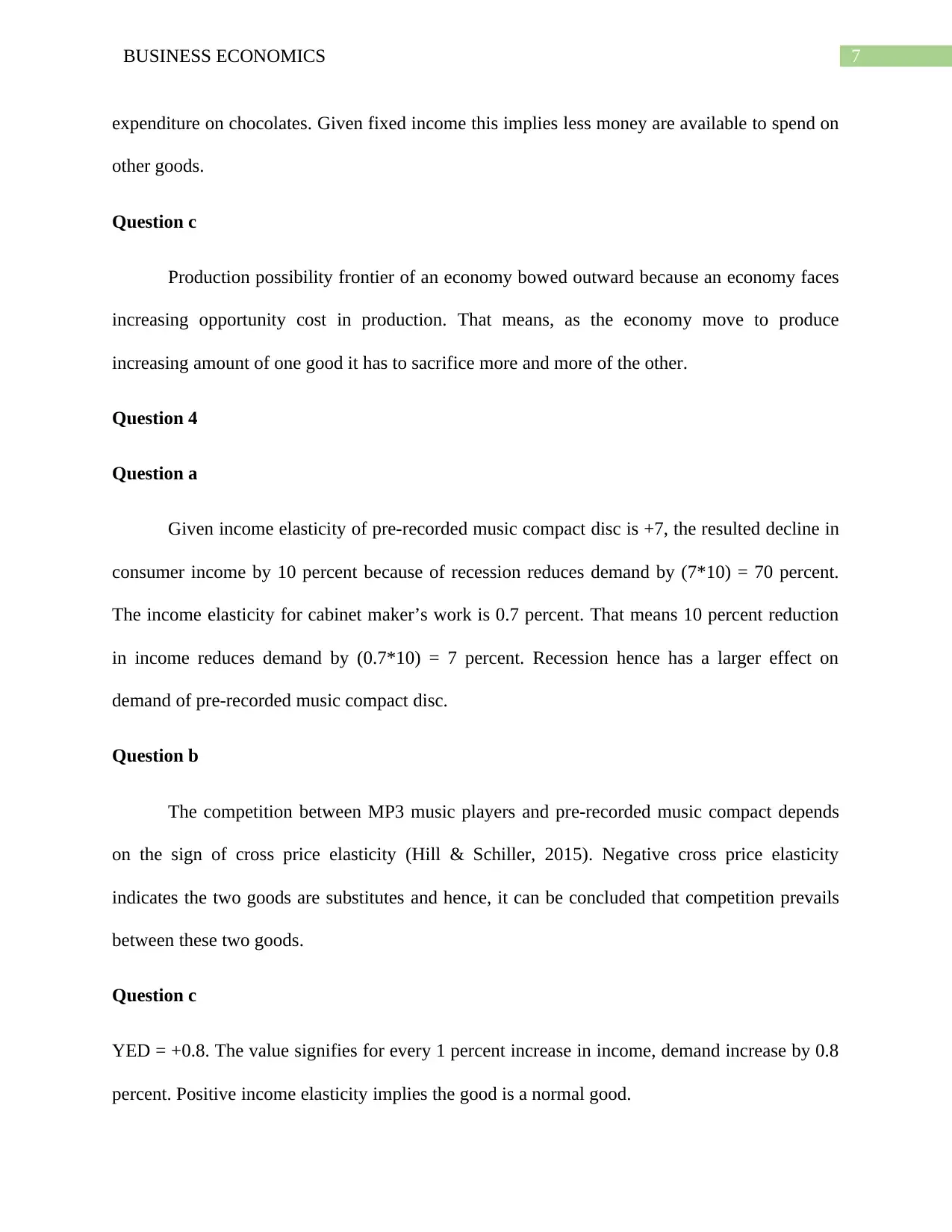
7BUSINESS ECONOMICS
expenditure on chocolates. Given fixed income this implies less money are available to spend on
other goods.
Question c
Production possibility frontier of an economy bowed outward because an economy faces
increasing opportunity cost in production. That means, as the economy move to produce
increasing amount of one good it has to sacrifice more and more of the other.
Question 4
Question a
Given income elasticity of pre-recorded music compact disc is +7, the resulted decline in
consumer income by 10 percent because of recession reduces demand by (7*10) = 70 percent.
The income elasticity for cabinet maker’s work is 0.7 percent. That means 10 percent reduction
in income reduces demand by (0.7*10) = 7 percent. Recession hence has a larger effect on
demand of pre-recorded music compact disc.
Question b
The competition between MP3 music players and pre-recorded music compact depends
on the sign of cross price elasticity (Hill & Schiller, 2015). Negative cross price elasticity
indicates the two goods are substitutes and hence, it can be concluded that competition prevails
between these two goods.
Question c
YED = +0.8. The value signifies for every 1 percent increase in income, demand increase by 0.8
percent. Positive income elasticity implies the good is a normal good.
expenditure on chocolates. Given fixed income this implies less money are available to spend on
other goods.
Question c
Production possibility frontier of an economy bowed outward because an economy faces
increasing opportunity cost in production. That means, as the economy move to produce
increasing amount of one good it has to sacrifice more and more of the other.
Question 4
Question a
Given income elasticity of pre-recorded music compact disc is +7, the resulted decline in
consumer income by 10 percent because of recession reduces demand by (7*10) = 70 percent.
The income elasticity for cabinet maker’s work is 0.7 percent. That means 10 percent reduction
in income reduces demand by (0.7*10) = 7 percent. Recession hence has a larger effect on
demand of pre-recorded music compact disc.
Question b
The competition between MP3 music players and pre-recorded music compact depends
on the sign of cross price elasticity (Hill & Schiller, 2015). Negative cross price elasticity
indicates the two goods are substitutes and hence, it can be concluded that competition prevails
between these two goods.
Question c
YED = +0.8. The value signifies for every 1 percent increase in income, demand increase by 0.8
percent. Positive income elasticity implies the good is a normal good.
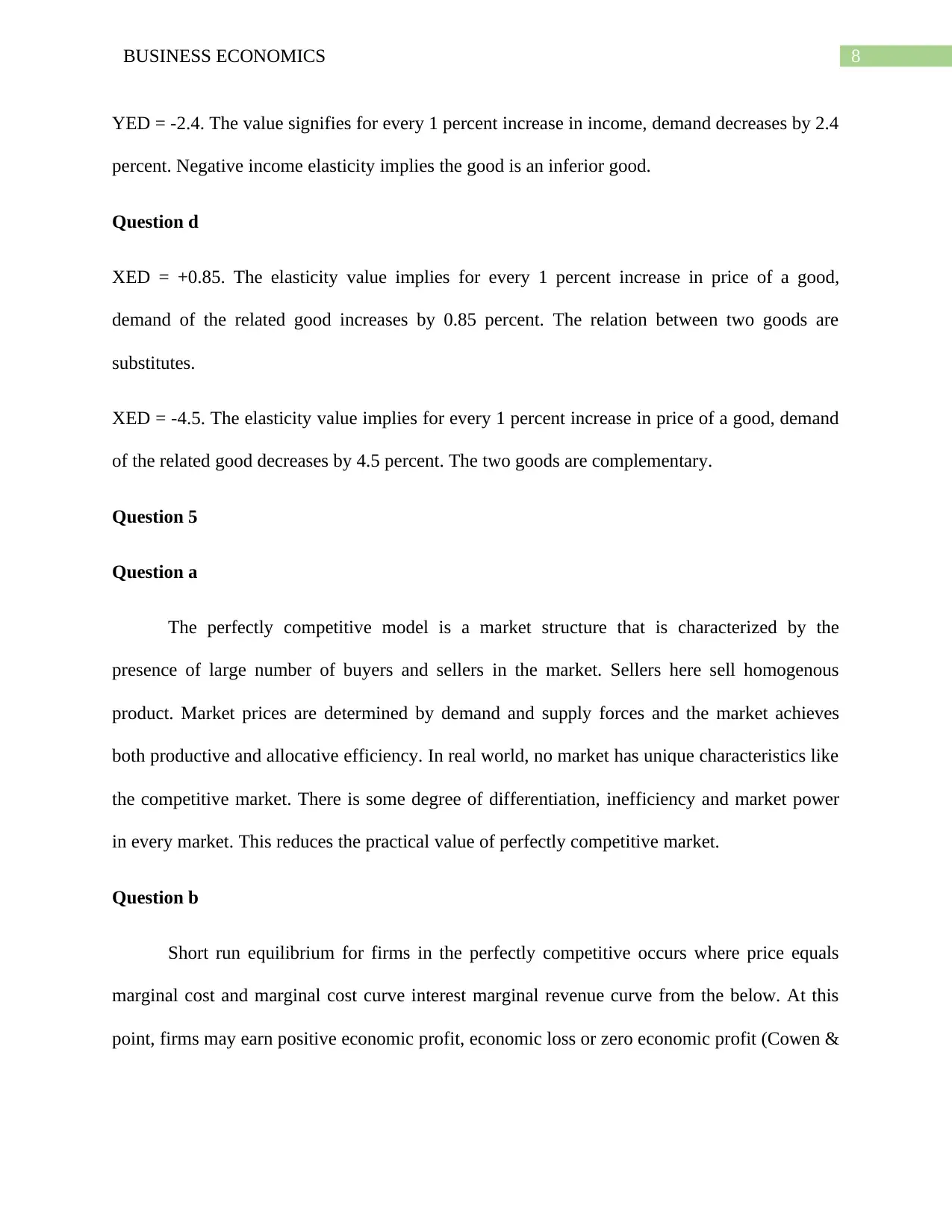
8BUSINESS ECONOMICS
YED = -2.4. The value signifies for every 1 percent increase in income, demand decreases by 2.4
percent. Negative income elasticity implies the good is an inferior good.
Question d
XED = +0.85. The elasticity value implies for every 1 percent increase in price of a good,
demand of the related good increases by 0.85 percent. The relation between two goods are
substitutes.
XED = -4.5. The elasticity value implies for every 1 percent increase in price of a good, demand
of the related good decreases by 4.5 percent. The two goods are complementary.
Question 5
Question a
The perfectly competitive model is a market structure that is characterized by the
presence of large number of buyers and sellers in the market. Sellers here sell homogenous
product. Market prices are determined by demand and supply forces and the market achieves
both productive and allocative efficiency. In real world, no market has unique characteristics like
the competitive market. There is some degree of differentiation, inefficiency and market power
in every market. This reduces the practical value of perfectly competitive market.
Question b
Short run equilibrium for firms in the perfectly competitive occurs where price equals
marginal cost and marginal cost curve interest marginal revenue curve from the below. At this
point, firms may earn positive economic profit, economic loss or zero economic profit (Cowen &
YED = -2.4. The value signifies for every 1 percent increase in income, demand decreases by 2.4
percent. Negative income elasticity implies the good is an inferior good.
Question d
XED = +0.85. The elasticity value implies for every 1 percent increase in price of a good,
demand of the related good increases by 0.85 percent. The relation between two goods are
substitutes.
XED = -4.5. The elasticity value implies for every 1 percent increase in price of a good, demand
of the related good decreases by 4.5 percent. The two goods are complementary.
Question 5
Question a
The perfectly competitive model is a market structure that is characterized by the
presence of large number of buyers and sellers in the market. Sellers here sell homogenous
product. Market prices are determined by demand and supply forces and the market achieves
both productive and allocative efficiency. In real world, no market has unique characteristics like
the competitive market. There is some degree of differentiation, inefficiency and market power
in every market. This reduces the practical value of perfectly competitive market.
Question b
Short run equilibrium for firms in the perfectly competitive occurs where price equals
marginal cost and marginal cost curve interest marginal revenue curve from the below. At this
point, firms may earn positive economic profit, economic loss or zero economic profit (Cowen &
⊘ This is a preview!⊘
Do you want full access?
Subscribe today to unlock all pages.

Trusted by 1+ million students worldwide
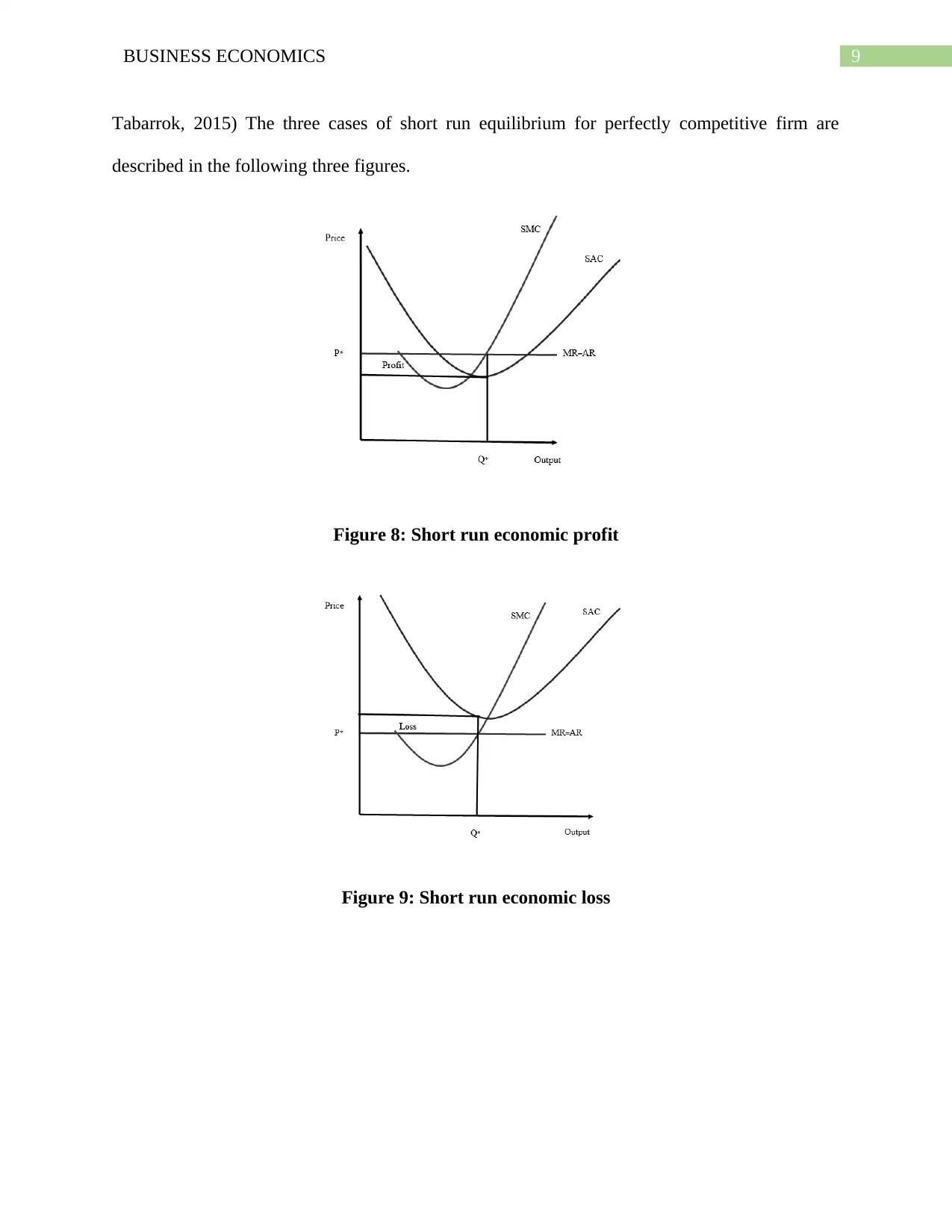
9BUSINESS ECONOMICS
Tabarrok, 2015) The three cases of short run equilibrium for perfectly competitive firm are
described in the following three figures.
Figure 8: Short run economic profit
Figure 9: Short run economic loss
Tabarrok, 2015) The three cases of short run equilibrium for perfectly competitive firm are
described in the following three figures.
Figure 8: Short run economic profit
Figure 9: Short run economic loss
Paraphrase This Document
Need a fresh take? Get an instant paraphrase of this document with our AI Paraphraser
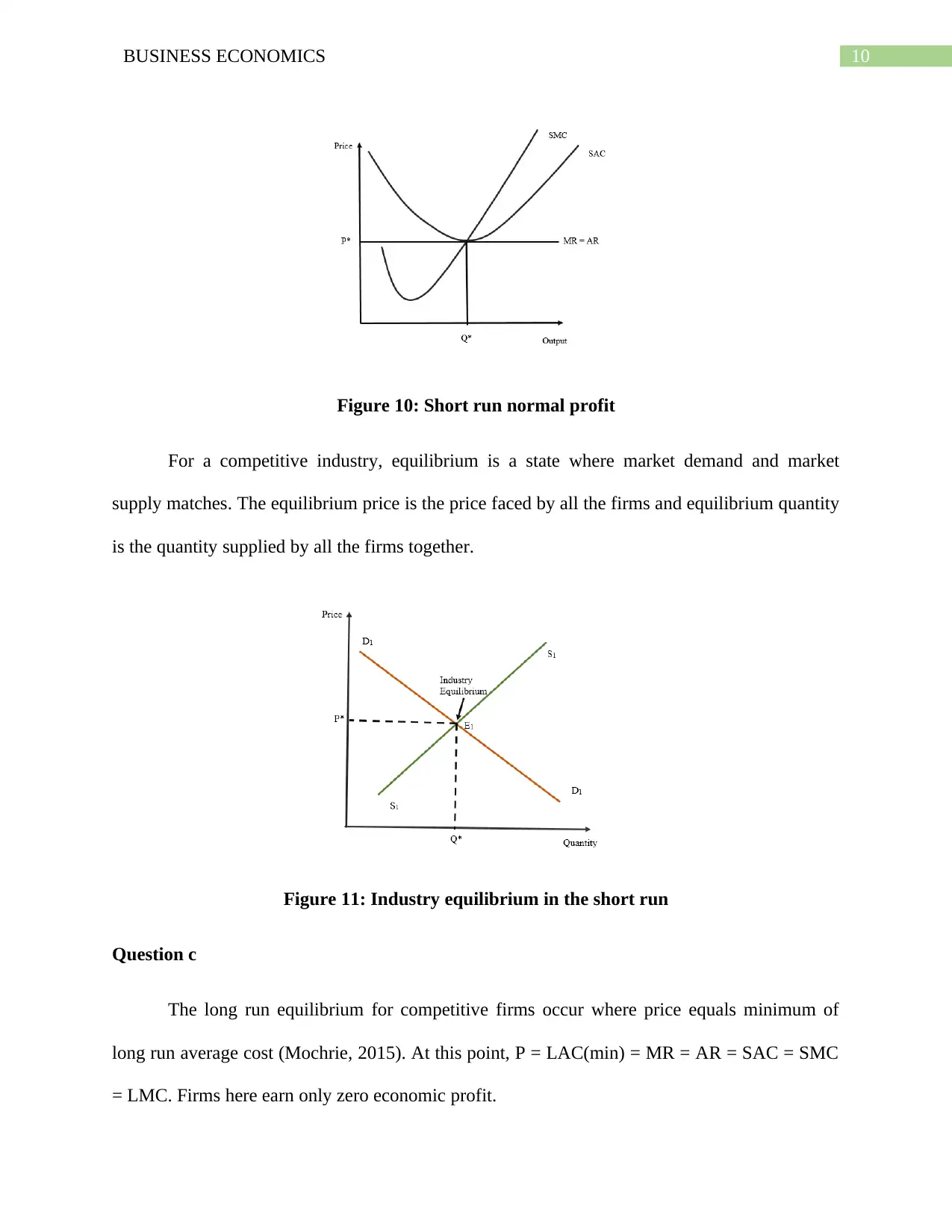
10BUSINESS ECONOMICS
Figure 10: Short run normal profit
For a competitive industry, equilibrium is a state where market demand and market
supply matches. The equilibrium price is the price faced by all the firms and equilibrium quantity
is the quantity supplied by all the firms together.
Figure 11: Industry equilibrium in the short run
Question c
The long run equilibrium for competitive firms occur where price equals minimum of
long run average cost (Mochrie, 2015). At this point, P = LAC(min) = MR = AR = SAC = SMC
= LMC. Firms here earn only zero economic profit.
Figure 10: Short run normal profit
For a competitive industry, equilibrium is a state where market demand and market
supply matches. The equilibrium price is the price faced by all the firms and equilibrium quantity
is the quantity supplied by all the firms together.
Figure 11: Industry equilibrium in the short run
Question c
The long run equilibrium for competitive firms occur where price equals minimum of
long run average cost (Mochrie, 2015). At this point, P = LAC(min) = MR = AR = SAC = SMC
= LMC. Firms here earn only zero economic profit.
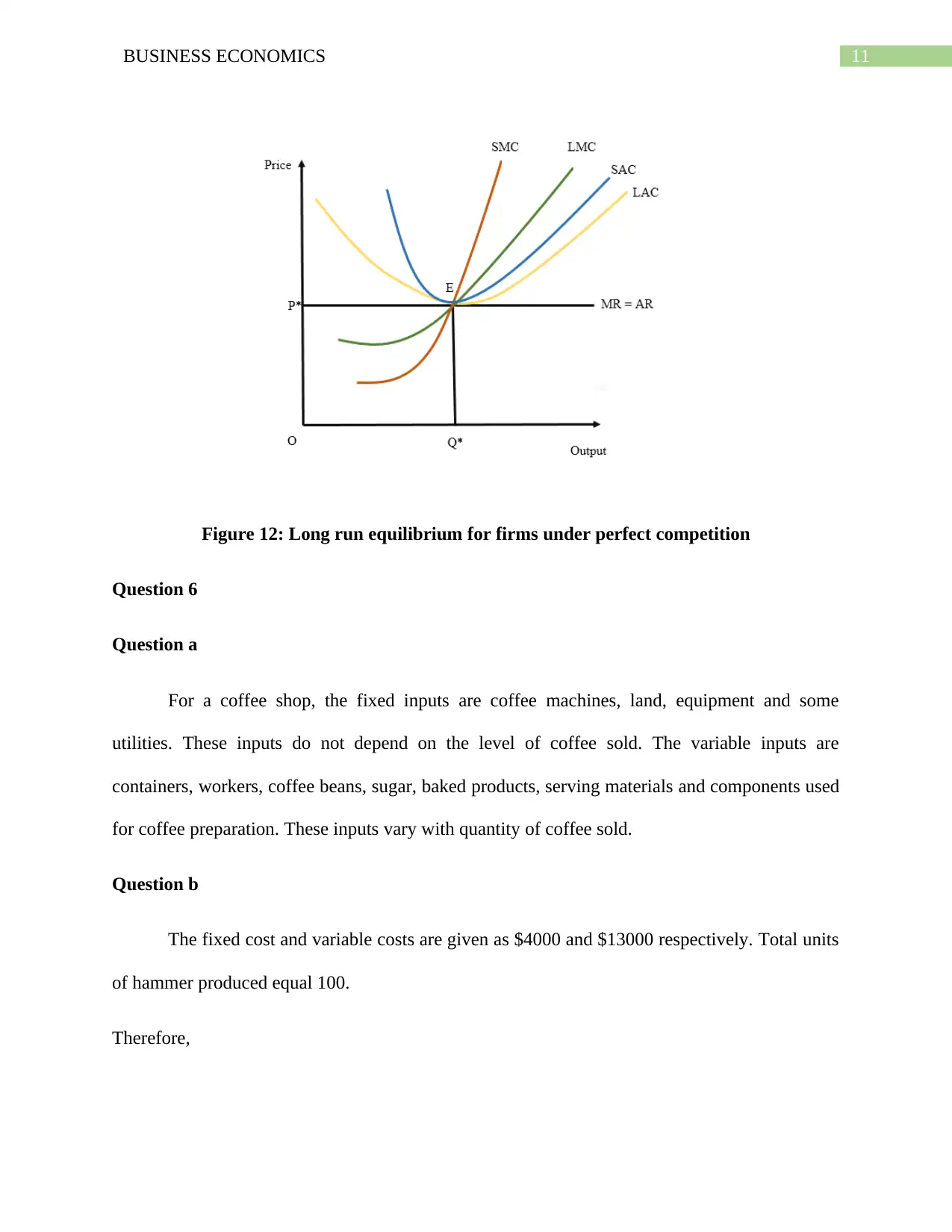
11BUSINESS ECONOMICS
Figure 12: Long run equilibrium for firms under perfect competition
Question 6
Question a
For a coffee shop, the fixed inputs are coffee machines, land, equipment and some
utilities. These inputs do not depend on the level of coffee sold. The variable inputs are
containers, workers, coffee beans, sugar, baked products, serving materials and components used
for coffee preparation. These inputs vary with quantity of coffee sold.
Question b
The fixed cost and variable costs are given as $4000 and $13000 respectively. Total units
of hammer produced equal 100.
Therefore,
Figure 12: Long run equilibrium for firms under perfect competition
Question 6
Question a
For a coffee shop, the fixed inputs are coffee machines, land, equipment and some
utilities. These inputs do not depend on the level of coffee sold. The variable inputs are
containers, workers, coffee beans, sugar, baked products, serving materials and components used
for coffee preparation. These inputs vary with quantity of coffee sold.
Question b
The fixed cost and variable costs are given as $4000 and $13000 respectively. Total units
of hammer produced equal 100.
Therefore,
⊘ This is a preview!⊘
Do you want full access?
Subscribe today to unlock all pages.

Trusted by 1+ million students worldwide
1 out of 24
Related Documents
Your All-in-One AI-Powered Toolkit for Academic Success.
+13062052269
info@desklib.com
Available 24*7 on WhatsApp / Email
![[object Object]](/_next/static/media/star-bottom.7253800d.svg)
Unlock your academic potential
Copyright © 2020–2025 A2Z Services. All Rights Reserved. Developed and managed by ZUCOL.




